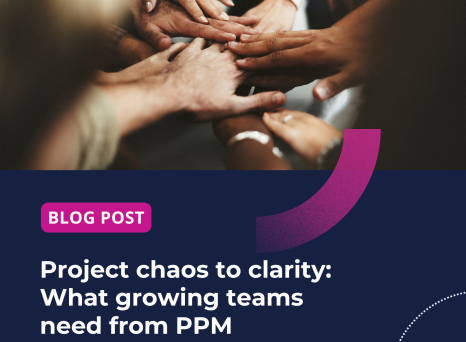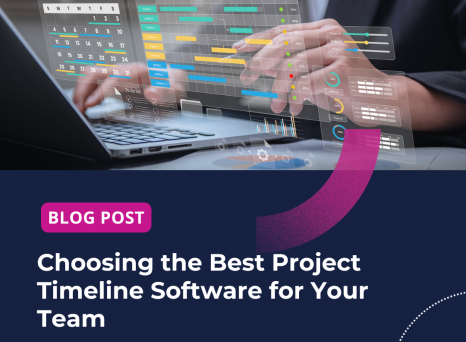Today’s project managers and leaders are more than just taskmasters; they create the structure, culture, and momentum needed to turn new ideas into reality.
By championing adaptive methodologies, leveraging data-driven insights, and fostering cross-functional collaboration, they help teams experiment and deliver value faster.
Whether implementing Agile in a traditional environment or using tech tools to streamline teamwork, project management professionals are at the forefront of innovation, transforming how work gets done to deliver successful outcomes—even in the face of growing complexity.
Why is innovation important in modern project management?
Innovation in project management means rethinking how teams plan, execute, and evaluate work. It’s about applying techniques that foster flexibility and continuous improvement, supported by tools that provide real-time data and seamless collaboration. The goal? Reduce inefficiencies, improve decision-making, and maximize the return on every project.
While the fundamentals of project management remain important, the environment in which projects operate has evolved. Portfolios are larger, cross-functional teams are the norm, and stakeholder expectations continue to rise. The demand for visibility, adaptability, and precision puts pressure on PMOs to move faster—without sacrificing quality or strategic alignment.
For PMOs, CIOs, and other senior leaders overseeing complex portfolios, traditional methods can quickly become bottlenecks, stalling delivery and clouding visibility across initiatives. In fact, PMOs at the enterprise level can serve as "Enterprise Innovation Engines," guiding smarter investments, better business cases, and stronger portfolio outcomes.
“Easier said than done”? Not necessarily—for those who embrace the right approach.
4 techniques to drive innovation in project management
While there’s no miracle recipe for enhancing innovation, leveraging specific practices and frameworks can help organizations accelerate their process.
1. Agile and hybrid methodologies
While Agile has long proven its value in software development, its principles are increasingly applied across industries to drive faster feedback loops and better alignment with evolving business needs.
By integrating regular retrospectives and stakeholder check-ins, project teams can adapt quickly and avoid late-stage surprises. This is especially useful for high-risk or fast-evolving projects. For larger, mixed-method environments, hybrid approaches offer the flexibility to combine Agile’s responsiveness with the structure of traditional linear models.
Take one leading energy utility, for example. To drive its transformation toward a climate-resilient energy system, the company combined SAFe, Agile, and Waterfall into one system, using the best of each to fit its needs.
By choosing a portfolio management solution with deep, cross-industry expertise, the utility was able to unify IT, construction, engineering, and operations on a unified platform.
That unified platform became a single source of truth for the firm’s entire book of work. Now, regardless of the methodology used to execute the work, data rolls up to program and value stream levels, empowering decision-makers and automating performance monitoring.
The results? A streamlined IT landscape, enhanced reporting, increased visibility and efficiency, and a boost in customer satisfaction.
2. Lean project management
Lean is an approach that enhances innovation and maximizes efficiency by continually optimizing processes through project lifecycles and cutting out waste—whether in time, budget, or human resources.
Lean focuses on eliminating non-essential tasks, reducing bottlenecks, and empowering teams to test small changes quickly. This creates space for faster experimentation and continuous improvement—teams can learn, adapt, and innovate without being held back by unnecessary processes.
Applying Lean principles helps project leaders prioritize high-value work and reduce overhead–especially in new product development, where the ability to deliver projects quickly and on budget is critical to success.
There are fantastic examples across all industries of organizations embracing Lean to drive innovation, including:
- Woodward: This aerospace and defense leader achieved a dramatic 75% reduction in overhead by harmonizing all of their project management operations. Time previously spent by project managers on compiling reports, aligning data, and bridging communication gaps is now focused on strategy and innovation.
- ABB: A technology leader in electrification and automation, ABB overhauled project execution across for over 2,500 global users by centralizing data and standardizing processes. After implementation of an SPM solution, they boosted real-time collaboration, reduced duplication, and improved decision-making—enhancing efficiency, cutting costs, and accelerating delivery of hugely complex projects.
- Teva: This global pharmaceutical company successfully consolidated processes and data into a centralized, unified single source of truth. Over time, this has led to a cultural change that has accelerated product launches and streamlined global team collaboration.
- Suntory Global Spirits: By adopting an SPM solution, this global beverage company drastically overhauled its commercialization processes, streamlining portfolios and internal processes. This resulted in an 18% increase in project delivery.
3. Data-driven decision making
Data isn’t about simply reporting on the past—it helps to predict and shape the future. Successful PMOs rely on timely, accurate data to inform everything from resource allocation to project prioritization. Establishing a strong reporting cadence, paired with visual dashboards, empowers leaders to make confident decisions.
Innovation-focused project managers should be using the latest capabilities (like AI analytics and forecasting, visualization tools, and “what-if” scenario planning—more on this a little later) to gain superior visibility, drive smarter decisions, and turn their data into a competitive advantage.
With this level of insight, your teams are empowered to continuously improve and, if necessary, to pivot and adjust. This is especially important for customer-oriented businesses, where market changes drive transformation. A good example is Metalsa, which manufactures vehicle components.
Our customers frequently ask for modifications. In order to protect our margins, we need to be better at identifying and managing all impacts of change requests.
— Iliana Martinez-Flores, Project System Coordinator at Metalsa
A powerful data management solution has provided the firm with an automated change management process that helps them respond to customer changes with greater accuracy, reinforces their project management system, and aligns with their digital transformation efforts.
4. Design thinking for project planning
Design thinking is a human-centered problem-solving planning process that emphasises creativity, empathy and iterative improvement throughout the project lifecycle. The aim is to create solutions that meet actual user requirements. The design thinking process involves:
- empathy: understanding the user’s pain points, frustrations, behaviors, and expectations before defining a project’s scope
- creative ideation: exploring multiple potential solutions, rather than prescribing one predefined plan
- prototyping: ensuring feedback loops and short and any experiments are conducted before full implementation and execution
- iterative testing: refining the product or project based on real-world feedback, not simply assumptions
This technique encourages early stakeholder involvement, helping teams define the right problems to solve before investing resources. PMOs often struggle with scope creep driven by unclear requirements. Design thinking promotes taking and clarifying perspectives, helping teams deliver exactly what stakeholders need—and not just what was initially requested.
Crucially, it promotes innovation by encouraging creative exploration and rapid, low-risk experimentation.
As evidenced by Metalsa’s story, innovation is enabled by the right toolset — not just more tools, but smarter, integrated solutions that support better visibility, automation, and collaboration.
Tools that enhance innovation capabilities and processes
The right tools don’t just support project management, t. They empower PMOs to push boundaries and make new ways of working possible. For example:
- Visual planning and timeline tools—like Gantt charts, calendar views, and Kanban boards—do more than track progress. They create a shared understanding that empowers teams to pivot quickly, spot risks early, and innovate faster.
- Collaborative workspaces and platforms break down traditional silos, enabling real-time input from diverse teams, and fostering the cross-pollination of ideas to spark creative problem-solving.
- Automation and workflow optimization tools free up valuable time by handling repetitive tasks like reminders, status updates, and approvals, allowing project managers and teams to focus their energy on experimentation and continuous improvement.
The age of AI project management
72% of project managers anticipate significant changes to their roles due to AI, with 80% believing that it will allow them to increase focus on leadership tasks.
They may well be right. From strategy to execution, data-driven AI can be integrated across all key areas of PPM, including:
- decision-making: “what-if” scenario planning and prioritization capabilities can support more strategic, insight-led choices across portfolios
- resourcing: AI enables dynamic resource allocation, scheduling, and estimation, reducing complexity and increasing agility
- risk management: AI-driven analysis of large volumes of data can uncover types and sources of risk faster and more reliably than traditional methods
- communication and collaboration: AI can enhance knowledge sharing and organizational learning across an organization and PPM professionals can engage directly with AI-powered bots and assistants (and even connect their own LLMs)
Together, these capabilities can accelerate project creation, ease user adoption, and improve data quality and forecasting.
Let’s consider the example of a global biopharma company. With their PPM platform’s AI-driven insights, they can analyze massive amounts of data and gain a deeper understanding of trends and patterns that might otherwise go unnoticed. In one recent project, the platform flagged a potential resource crunch just before a major cancer trial was set to begin—a delay that could have set their timelines back by months. Thanks to this early warning, the team adjusted schedules, reallocated resources, and kept the trial on track.
Download our whitepaper for more examples of how AI can help PPM “grandmasters” improve portfolio optimization with better project and program prioritization, budgeting, and strategic planning.
Stack the odds in your favour with a comprehensive innovation management solution
Granted, technology alone doesn’t spark transformation. Organizations looking to enhance innovation should foster continuous learning, cross-functional collaboration, and process maturity.
That said, the use cases highlighted above clearly demonstrate how technology can act as a catalyst. To maximize your tech investment, it’s essential to choose a robust, end-to-end solution—like Planisware. Our platform seamlessly supports a wide range of project and portfolio management methodologies while leveraging advanced data intelligence to accelerate outcomes.
See for yourself how a solution like ours can enhance your organization’s processes and capabilities by booking a demo.

